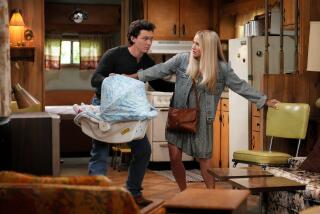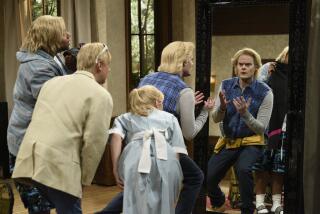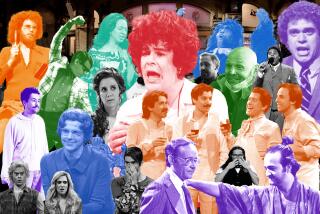Classic Hollywood: For holiday cheer, check out these ‘30s and ‘40s comedies
Let’s face it, sometimes the holiday season is as depressing as a stale piece of fruitcake. If the thought of the usual Christmas movies leaves you cold, here’s another way to shake the holiday blues away: a selection of classic comedies from the 1930s and ‘40s. Here are a few of our favorites; if you can’t laugh at these, you really are a Scrooge.
“Horse Feathers” (1932)
For those who love Marxist comedies — as in the Marx Brothers — their early Paramount films are far funnier and more anarchic than the more staid MGM releases. Here Groucho, Chico, Harpo and Zeppo take on the institution of higher education in this wild and crazy farce. Groucho plays Professor Wagstaff, the president of Huxley College, who decides to bolster enrollment by staging a winning football game. Zeppo plays his son, Chico is a bootlegger and ice salesman and Harpo is the dog catcher who is more interested in catching women. The smart, funny script was penned by Bert Kalmar, Harry Ruby and S.J. Perelman, and Ruby also co-wrote the musical numbers that include the classics “Whatever It Is, I’m Against It” and “Everyone Says I Love You.”
“It Happened One Night” (1934)
This Oscar-winning romantic farce is considered the granddaddy of the screwball comedy genre. It won the Oscar for best film, actor for Clark Gable, actress for Claudette Colbert, director for Frank Capra and screenplay for Robert Riskin. Colbert plays a spoiled heiress who runs away from her impending marriage to an aviator and sets out on the lam. Gable is a down-on-his-luck newspaper reporter who recognizes her when she gets on a bus and decides to befriend her so he can get an exclusive. Of course, they fall in love before the fade out. Don’t miss the scene in which they’re sharing a hotel room and Gable shows Colbert the order in which he undresses. The fact that Gable didn’t wear an undershirt caused a sensation.
“It’s a Gift” (1934)
Let us now praise Mr. Muckle and Carl LaFong. They are involved in two of the best gags in what is arguably W.C. Fields’ most satisfying comedy. Fields, who helped write the script under the nom de plume of Charles Bogle, plays Harold Bissonette, a small-town shopkeeper who is constantly being beaten down by his family, friends and customers, such as Mr. Muckle (Charles Sellon), a cranky blind man who is hard of hearing and by turns destroys everything in sight at Bissonette’s store. Another high point finds Bissonette trying to sleep on the family’s porch, where he is harassed by an insurance salesman looking for a man called Carl LaFong. The final scene was shot at Fields’ own, new 7-acre estate in Encino.
“Easy Living” (1937)
Along with Carole Lombard and Irene Dunne, Jean Arthur was one of the queens of comedy during the 1930s and ‘40s. She gives one of her best, breathlessly funny turns in this sparkling screwball comedy penned by the great Preston Sturges — his first film under contract at Paramount — and directed by former production designer Mitchell Leisen. Set in New York City, the film features Arthur playing a clerk named Mary Smith, who is sitting on a double-decker bus one day when an expensive fur coat falls out of a window and lands on her head. Needless to say her life is never the same. Edward Arnold plays the rich investor who threw out the coat and Ray Milland is his son, who is trying to make it without his daddy’s help.
“Ball of Fire” (1941)
Gary Cooper and Barbara Stanwyck starred in two films in 1941: Frank Capra’s political fable “Meet John Doe” and this delicious Howard Hawks-directed comedy. It features a razor-sharp script from none other than Billy Wilder and Charles Brackett, a clever reimagining of “ Snow White and the Seven Dwarfs.”
Cooper plays the shy, earnest young professor named Bertram Potts, who is living with a group of eccentric professors compiling an encyclopedia of human knowledge. While Potts is doing research on modern slang, he becomes interested in a burlesque performer named “Sugarpuss” O’Shea (Stanwyck in her Oscar-nominated performance). She isn’t interested in helping him with his research until the cops show up wanting to question her about her mob boss boyfriend ( Dana Andrews). Hiding out from the cops, she takes refuge at the professor’s house and it isn’t long before Sugarpuss and Bertram fall in love. Martha Tilton provided Stanwyck’s vocals for her “Drum Boogie” number, which is performed by the famed Gene Krupa and his band. ( Ginger Rogers and Carole Lombard turned down the role. Lucille Ball almost had the job until Cooper recommended Stanwyck).
And with that a good night.
Drew Barrymore’s great uncle appears in 1946’s “It’s a Wonderful Life.” Who is he?
Lionel Barrymore



